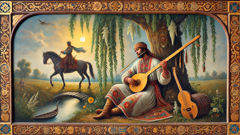Introduction
The first time anyone set eyes on Cossack Mamay in a painted panel or a wandering minstrel's song, they recognized a stillness that was also motion: a man seated, bandura across his lap, boots planted on the sun-baked earth, eyes turned toward the river where light shivered like spoken truth. He carried no crowd of banners nor a retinue of trumpets; his weapons hung nearby—a sabre at ease, a musket propped aside—but it was the instrument, the bandura, that governed the scene. In village taverns and noble salons, the image of Mamay became shorthand for a certain ideal: a warrior who preferred song to slaughter, a watchful guardian whose courage showed in patience rather than in fury. This persona was not a single historical person so much as a mirror into the Cossack mind, an archetype born of the steppe's breath and the river's memory. Over decades and centuries, Mamay's portrait was painted in the corners of homes, in church-like icons, and later reproduced as prints that households clipped and pinned above stovetops and beds. Each household version carried small differences—sometimes a tree, sometimes a horse, sometimes a smoking pipe—yet the essentials remained: the bandura, the open space, the quiet face, and the sense that the man belonged to the land as much as he served it. This story moves through the pigments and the plucked strings to find the roots of Mamay's meaning: how folk painters, oral poets, and wandering musicians welded image to idea; how that image survived raids, reforms, and the shifting borders of empires; and how, in the present, Mamay keeps returning as a symbol that Americans and Europeans can read as picturesque, but Ukrainians feel as blood memory. In the following pages you'll meet the painted panels and the real riverside places that anchor Mamay, hear the imagined songs he might have played, and follow the legend's journey from the hearth until it becomes a living part of national imagination. You'll see how a simple motif—man, instrument, open steppe—grew into a complex emblem capable of carrying grief, humor, defiance, and comfort through generations.
Origins and Iconography: How Mamay Became a Painting
The earliest echoes of Mamay's image come from a mixture of folk painting and oral memory that circulated in the 17th and 18th centuries, at the crossroads of frontier life and imperial pressure. To understand how a painted figure could gather such a thick web of meaning, start with the materials: tempera and oil on wood, crude palettes made from soot and homemade pigments, the household uses of these panels. Paintings of Mamay were often done by house painters or itinerant iconographers who understood both religious icon traditions and the more private, domestic aesthetics of peasant taste. That hybrid practice ensured Mamay's look balanced sacred seriousness with the everyday marks of peasant life. Look closer, and you see a small canon of symbols reappearing across versions: an embroidered shirt that marks regional identity, wide trousers that speak to mobility, a broad belt for carrying tools and weapons, the bandura as proof of art and thought, a curved saber that is at once poetry's punctuation and a utilitarian blade, and a horse—sometimes distant, sometimes present—to imply journey and possibility. The bandura deserves special note. Instrument, object, and metaphor all at once, in Mamay's hands it becomes the means by which a warrior reclaims his agency. Unlike drums or horns that call soldiers to arms, the bandura invites listening. Stringed instruments had long been associated with bards and recorders of communal memory across Eastern Europe, and in Ukraine they were bound to specific narratives, songs that told of raids and harvests, of lost lovers and brave deeds. For Mamay, the bandura implied that heroism could be ethical and reflective; he is a guardian through song rather than solely through slaughter. The background elements in Mamay paintings also carry layered meanings. A willow tree may lean as witness to the river's edge, a river itself suggests migration routes and trade, and a small house may connect the figure to family and hearth. Some panels show Mamay with a pipe, a set of cards, or a pot of stewing food—details intended to normalize him and make him an accessible figure for daily devotion. His gaze is often steady but not aggressive. Painters learned to suggest an inwardness—eyes that watch the world more than they threaten it. As an image that circulated in humble kitchens, Mamay functioned like a talisman: a reminder that dignity does not require wealth, that strength needn't be loud, and that an individual bound to community could serve as both protector and poet. Overlaid on these domestic motifs are political subtexts. During the long 18th century, the Zaporizhian Cossacks had complex relations with surrounding empires—the Polish-Lithuanian Commonwealth, the Ottoman world, and the growing Russian state. Mamay's unarmed composition at times acted as quiet resistance, an aesthetic refusal to be assimilated into foreign heraldry. By foregrounding a cultural toolkit—song, craft, and a specific style of dress—folk painters made a visual language that could be read as devotion to a way of life rather than allegiance to a crown. Folklorists and ethnographers later mapped Mamay's spread. When collectors and scholars in the 19th century traveled the villages and recorded these paintings, they discovered subtle local variations that betrayed a living tradition. In the Dnieper region Mamay might be flanked by fishermen and nets; in Poltava he could be near broad fields and a furrowed plough; in the Carpathians a Mamay panel might swap the bandura for a related stringed instrument, or place the figure beneath a different tree. These shifts did more than decorate: they localized the myth, making Mamay less like an imported saint and more like an ancestor in each place he appeared. That adaptability became part of his strength. The image was both stable and malleable: stable in its central message, malleable in how that message spoke to each community's specific fears and hopes. Artists who painted Mamay rarely wrote down their intent; instead, the image acquired meaning through repeated communal use. People invoked him at weddings and funerals, in tales told by hearth-light, and in petitions to local leaders. The paint itself, layered over decades and varnished and retouched, served as a palimpsest of communal memory. Later, printers would reproduce Mamay on sheets for sale, and his likeness spread into urban centers as well as remaining rooted in villages. This migration from vernacular object to printed art mirrored Ukraine's own shifting cultures—rural and urban, peasant and merchant, local and cosmopolitan. When scholars attempted to trace a single prototype, they found instead a constellation of likenesses, each reflecting a local heart. Mamay's iconography, then, is a study in how a culture invents a hero at its own scale. He's a local saint of patience, a guardian whose weapon never leaves his side but whose hand prefers strings. That duality—prepared yet reflective—allowed Mamay to survive eras that punished overt rebellion. He offered a way for people to keep identity without waving a flag that might invite retaliation. In villages, Mamay was painted not to foment revolution but to preserve a sense of who the people were, and that preservation proved its own kind of resistance.

Songs, Battles, and the Bandura: The Living Voice of Mamay
If iconography supplied the frame, it is through songs and stories that Mamay's figure began to breathe. Oral tradition kept him alive in stanzas and refrains, in tales told by hearth-side and in the records of traveling kobzars—professional musicians who both entertained and preserved communal memory. The kobzar was a real person and a symbolic figure; his instrument, often a bandura or kobza, acted as portable archive. These traveling bards memorized and improvised epics that tied communities together, recounting raids, floods, births, and deaths. When Mamay appears in these songs, he's seldom described as an infallible hero. Instead, he's a man who feels the weight of history in his chest, who chooses to sing in moments where others would raise weapons. In one common motif, Mamay meets a passing commander who props his musket near the river and asks the solitary player whether it's time for war. Mamay plucks a chord and answers with a story—about fields that will be trampled if war comes, about children who will lose names and songs, about old friends who won't come home. The commander wonders if Mamay's counsel is cowardice, and Mamay replies with a single, measured note that becomes a kind of moral ultimatum: to choose what is worth defending and to know when to wield the sword. These tales emphasize choice more than fate. In the context of frontier life, where raids and reprisals could sweep across villages, such nuance allowed communities to imagine a different kind of courage—wisdom that weighed consequence. The bandura, in this view, does not degrade bravery; it refines it. It becomes both record and remedy: the strings hold memory, while music can ease wounds and summon hope. Beyond parable, Mamay's songs often narrate real historical tensions. As the Zaporizhian Sich dissolved and Cossack autonomy waned under imperial expansion, Mamay's figure was invoked in laments that were as much about lost self-governance as they were about lost men. Music recorded absenteeism—men taken to foreign service, young people leaving for trade, elders dying without heirs—and turned private grief into public history. In the 19th century, when ethnographers began to transcribe these songs, they found embedded accounts of skirmishes, treaties, and betrayals. The kobzars' melodies could be oblique yet accurate; they preserved names and places by weaving them into refrains that were easy to memorize. At times, Mamay figures in direct resistance: sketched in verses that encourage covert defiance, or mentioned in songs used to rally people discreetly. Yet Mamay's signature was never a battlefield frenzy. Even in stories where he goes to war, he is portrayed as a leader who returns to the bandura afterward, to sing of what was lost and to humanize the cost. This cyclical return—instruments after action—keeps moral perspective centered. The music also shaped gendered perception. While Cossack society was predominantly male in public military spaces, palatable images of Mamay included domesticity: guests seated by the hearth, a woman bringing bread, or a child's head leaning against his knee as he plays. Such scenes remind listeners that the martial ideal coexisted with the responsibilities of family and village. The songs sometimes recount tender moments that make Mamay more than myth: a lullaby for a newborn, a dirge for a river-swept brother, a jest shared with neighbors. These smaller lines anchor grander themes and make the legend digestible across classes and ages. Migratory movement and the diaspora spread Mamay even further. When Ukrainians traveled for work or fled conflict, the portrait and the songs traveled with them. Print culture in the 19th century accelerated this diffusion: cheap prints of Mamay found new life on the walls of towns and in émigré communities. At the same time, modernization threatened the kobzar tradition. Laws and cultural change pushed some musicians out of the trade; some instruments altered by urban tastes. Yet Mamay adapted. In urban ballads he might become a poet on a bench, in revolutionary songs he sometimes slotted into rhetoric as a symbol of a proud but pacific nationhood, and in children’s rhymes he turned into an affable grandfather. The elasticity of Mamay’s legend explains how he survived both imperial suppression and the homogenizing pressures of modern nation-building. When photographers and later painters revived folk images for national revival movements, Mamay was called upon as an emblem precisely because he sat at the junction of several desires: the need for a nonviolent exemplar, the wish to root national identity in everyday life, and the demand for continuity with a storied past. Across centuries, artists and musicians reinterpreted the bandura's timbre to suit their times: melancholic in an occupied village, defiant in a reformer's pamphlet, tender in a lullaby album. Contemporary performers who resurrect kobzar songs frequently rework them, adding harmonies, swapping tempos, and thus linking past memory to present sensibilities. The result is a living tradition rather than a fossilized image. The endurance of Mamay’s music also reflects its adaptability to narrative technique. Storytellers use Mamay as a moral device: his presence can be the turning point in a tale where characters learn modesty, courage, or communal responsibility. Novels and plays in later centuries reimagined him: sometimes as protagonist, sometimes as an ideal characters try to emulate. Film and theater have also taken Mamay into modern languages of storytelling. Directors stage him under different lights—literally—with golden-hour cinematography that references painted panels, or close-ups on fingers to emphasize craft and care. In each retelling, the bandura remains pivotal; it is the instrument of translation between private sorrow and public memory. Finally, Mamay's songs and portraits act as mnemonic anchors for national grief and pride. Songs that once told of a single raid can, in later decades, be repurposed to recall a flood, a famine, or a moment of political upheaval; the emotive power of melody compresses time and makes disparate experiences legible under a shared aesthetic. In that way, Mamay is less a historical person and more an ongoing dialogue among Ukrainians—between what has been lost and what must be remembered—always plucking strings that keep memory in tune.

Conclusion
Mamay's endurance is no accident; it reflects how societies choose symbols to carry their longings. He is not a simple patriotic poster or a militaristic idol but a porous image that invites interpretation. When townsfolk pin a Mamay panel over the stove, when a grandfather hums a kobzar refrain to his grandchildren, when an artist reimagines him for a gallery, they perform an act of cultural continuity. The myth compresses many tensions: warrior and peacemaker, local and national, memory and improvisation. Yet across these tensions the central lesson gleams: that courage is not a single gesture but a habit of attention. Mamay teaches listening—listening to land, to song, and to consequences. He reminds us that instruments can be tools of resistance as much as weapons, that a community's voice is sometimes stronger than the clangor of arms, and that identity can be cultivated in domestic spaces as readily as on battlefields. In contemporary times, when Ukrainian culture faces renewed questions about preservation and representation, Mamay remains both a refuge and a challenge. He asks those who invoke him to do so with care: to honor nuance, to preserve song, and to recognize that his image belongs not to one political line but to a mosaic of human needs and memories. To sit with Mamay is to sit with a tradition that survived empires and reforms by insisting on the enduring importance of song. He is a figure who knows that some battles are external and others internal, and that the truest victory may be a life lived with dignity, witness, and melody.













